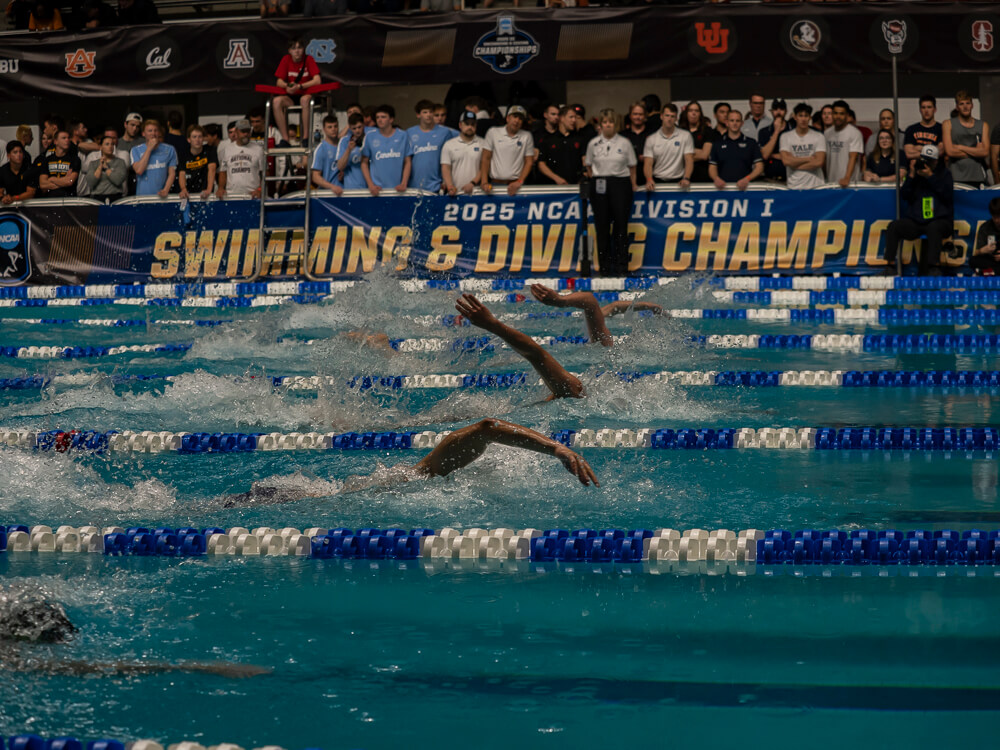NCAA Swimming Championships Overhaul and New Event Lineup Approved
The NCAA Swimming and Diving Championships will look drastically different in March 2026. The College Swim Coaches Association announced Friday that the NCAA Swimming and Diving Oversight Committee approved the changes first proposed in the spring to modernize the competition with a new format and event schedule.
The initial proposal was “designed to support collegiate swimming and diving by modernizing the championship format to better align with broadcast needs, while expanding institutional access through an updated qualification process.” The CSCAA and other involved organizations sought to create “a high-stakes, heavyweight experience — where every session matters and every race or dive has the power to shift the standings, elevating both the intensity and visibility of the championship and the sport.”
The full details of the revamped format were not immediately available, but the proposal from the spring eliminated consolation finals, with swimmers placing ninth through 16th earning points based on swims during the preliminary session. Additionally, diving during the finals session was set to be split into a pair of three-dive segments rather than staging all six dives toward the end of each evening session between individual events and relays. Swimmers would thus have two short breaks during finals.
The reconstructed schedule proposals released in the spring moved timed finals of the 1650 freestyle to the Wednesday evening session, with the fastest eight seeds competing just before the two relays typically held that day. Other individual events had been moved between days, with stakeholders hoping to maximize high-stakes competition over the last two days of the meet.
Relays would stay in the same spots in which they have been in recent years, with one at the end of the Thursday, Friday and Saturday evening sessions. There was a consideration of returning relays to a prelims-finals format, which has not been used at the NCAA Championships since 2019. It’s unclear if that change has been adopted.
Finally, the “A” and “B” time standards typically used for NCAA qualifying were to be eliminated and replaced with a single time standard approximating the 72nd-place time in the event from one year earlier. In a switch designed to increase institutional representation at the NCAA Championships, all swimmers who won a conference title in any event would receive an automatic bid to the NCAA Championships, provided they swam under the new qualifying standard. Further selection for the meet would remain largely unchanged, with the top swimmers entered in each event earning bids until the roster cap was reached.
The adoption of the proposal was finalized September 24. According to the CSCAA release, “The proposal reflects years of conversations, committee meetings, and input from industry leaders across the collegiate swimming and diving ecosystem. The changes are supported by USA Swimming, USA Diving, the American Swim Coaches Association (ASCA), and Lasser Productions (producer of the NCAA Swimming and Diving Championships for ESPN for the past 15 years), and are the result of a careful assessment of both current needs and the future of the sport.”
CSCAA Executive Director Samantha Barany endorsed the changes as critical for the future of the sport following a long process of innovation. “In a moment that demands forward momentum, the NCAA Committee has taken a step to advance our sport,” Barany said in the press release. “It may not be perfect — few things ever are — but it is a step, not the final destination. Doing nothing would leave our sport far more vulnerable than taking proactive action, and the CSCAA is ready to work with the NCAA to make the next iteration of our Division I championship a success for everyone.”
This change comes a decade after the women’s and men’s Division I championship meets expanded from three days to four. Initially, the 800 freestyle relay was moved from Friday evening to its own session Wednesday, with the other individual events and relays remaining in their usual spots. The change immediately produced a run of blazing relay times to kick off the meets.
Further changes followed during the COVID-19 pandemic. After the cancellation of the 2020 meet immediately after the pandemic began, the championships returned in 2021 with 200 and 400-yard relays moved to a timed finals format. That change would remain in place in future seasons, with the 200 medley relay also moved to Wednesday evening’s session beginning in 2022.
But during all those adjustments involving relays, the slate of individual races remained the same: the 500 free, 200 IM and 50 free Thursday; the 400 IM, 200 free and 100s of stroke Friday; and the 200s of stroke plus the 100 and 1650 free Saturday. The changes this time are far more dramatic, with the 1650 free beginning individual racing in the Wednesday session while several other events will take place at different times during the meet.
